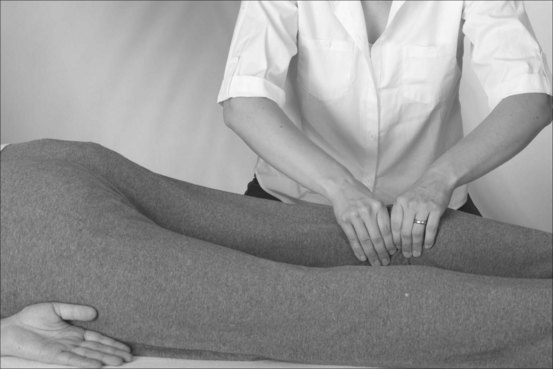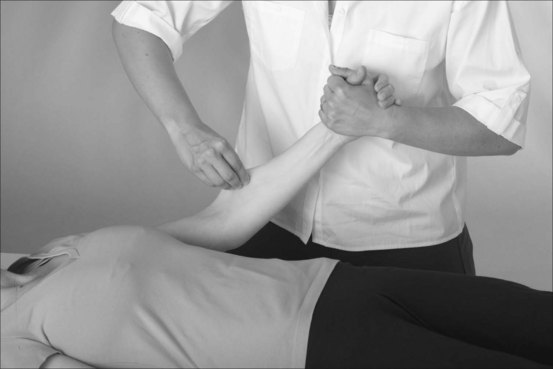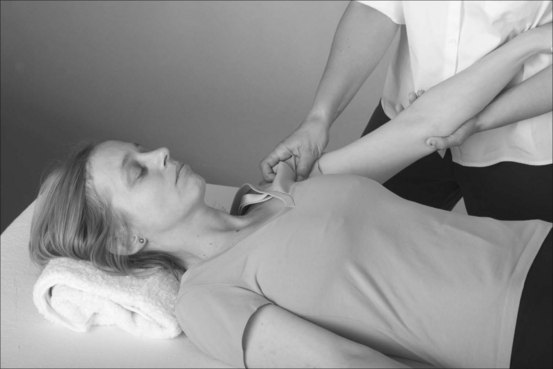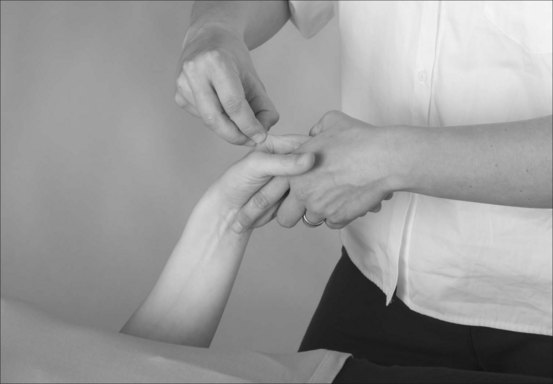CHAPTER 4 Compound techniques
Compound techniques using Na fa
There are seven compound techniques that use Na fa as the root technique. They are:
1. Holding–grasping 
Holding–grasping can be applied repeatedly in one particular area such as the deltoid muscle, or along the course of the channel’s sinews. You can use one or both hands depending on the area to be treated and the size of your patient. (Fig. 4.1)
Clinical application and therapeutic effects
2. Pinching–grasping 
Pinching–grasping can be applied with consistent repetition in one fixed place or along the course of a channel. It should be applied until the patient feels a sensation of soreness, numbness or distension. (Fig. 4.2)
Clinical application and therapeutic effects
Therapeutic effects
These are wide and varied as it depends on which channels are being stimulated.
• When applied to the Yin channels of the arms it will help to clear the Lungs, stop a cough, resolve Phlegm, aid respiration and calm the Shen.
• Applied to the Stomach, Spleen and Liver channels it can help to regulate and encourage digestion.
• When applied to the leg channels, it will move Qi and Blood in the abdomen.
• Generally, pinching–grasping will invigorate the flow of Qi and Blood, relax the muscles and open the channels.
Common uses
• Include pinching–grasping in your treatment of mental/emotional problems such as anxiety, depression, panic attacks and palpitations.
• You can use it for respiratory conditions such as asthma, acute and chronic cough and difficulty breathing due to retention of Phlegm.
• Use it for feelings of oppression in the chest and ribs from Phlegm or Qi stagnation.
• Apply to the leg channels for digestive problems such as hiccup, belching and flatulence, abdominal pain and distension caused by Shi conditions and for dysmenorrhea from Qi stagnation and Blood stasis.
3. Grabbing–grasping
Grabbing–grasping is quite an intense technique: keep relaxed, brisk and rhythmic; use your Qi and do not let it become harsh. (Fig. 4.3)
Clinical application and therapeutic effects
Where to apply the technique on the body
Grabbing–grasping can be applied to the head, neck and nape, the back, abdomen, arms and legs.
Common uses
• It is definitely worth considering in cases where you have Wind obstructing the channels creating stiff contracted sinews in the arms and legs. For example, you may see extreme cases of this in cerebral palsy and multiple sclerosis (MS) when the legs or arms cannot be straightened.
• It can also be used as part of treatment for headaches and migraine, common cold and flu.
• It is a useful technique to apply to the belly for abdominal pain from stasis of Blood and retention of Cold or Cold and Damp.
• It can be used as part of treatment for diarrhea caused by Cold and Damp patterns with Weak Spleen.
• It can also help in cases where flow of urine is impeded or blocked by accumulations and stagnation.
4. Nipping–grasping 
Clinical application and therapeutic effects
Where to apply the technique on the body
It is commonly applied to the neck and nape, the shoulders, elbows, wrists, knees and ankles. (Fig. 4.4)
< div class='tao-gold-member'>
Stay updated, free articles. Join our Telegram channel

Full access? Get Clinical Tree









